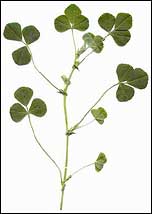Medicago truncatulaTaxonomy: Eukaryota; Viridiplantae; Streptophyta; Streptophytina; Embryophyta; Tracheophyta; Euphyllophyta; Spermatophyta; Magnoliophyta; eudicotyledons; core eudicotyledons; rosids; eurosids I; Fabales; Fabaceae; Papilionoideae; Trifolieae; Medicago
Introduction Animals need both energy and protein in their food. BSE or mad cow disease, which led to the removal of animal-derived protein from livestock feed, has highlighted the shortfall in vegetable protein sources. Europe imports 75% of its plant-derived protein, mostly as soyabean meal. For this reason, the European Union wants to encourage farmers to grow protein-rich legume crops like peas and faba beans for animal feeds. Such plants are currently under-used in European agriculture, despite having the advantage of reducing fertiliser and pesticide inputs, which is better for the environment. A large Integrated Project called 'Grain Legumes' is combining the efforts of scientists from 18 countries in order to make legume crops more competitive for European agriculture, using the latest progress in genomics and ranging from plant improvement and crop management to feed processing. Animals need both energy and protein in their food. BSE or mad cow disease, which led to the removal of animal-derived protein from livestock feed, has highlighted the shortfall in vegetable protein sources. Europe imports 75% of its plant-derived protein, mostly as soyabean meal. For this reason, the European Union wants to encourage farmers to grow protein-rich legume crops like peas and faba beans for animal feeds. Such plants are currently under-used in European agriculture, despite having the advantage of reducing fertiliser and pesticide inputs, which is better for the environment. A large Integrated Project called 'Grain Legumes' is combining the efforts of scientists from 18 countries in order to make legume crops more competitive for European agriculture, using the latest progress in genomics and ranging from plant improvement and crop management to feed processing.The overriding aim of the Grain Legumes project is to provide tools to facilitate genetics and to develop new varieties of legumes alongside new ways of growing, treating, processing and using them. The strategy is to accelerate plant breeding by harnessing the progress in the description of legume genes and their genome organisation. The legume codeMedicago truncatula is the model-organism for plant biology in legumes. With 650 genera and over 16000 species, legumes are second only to grasses in economic importance in world agriculture but progress towards understanding the genetic code of legume crops lags behind other crops such as cereals. The importance of legumes to global agriculture and the need to understand important biological functions not found in existing plant models make M.truncatula exceptionally interesting for sequencing. Medicago truncatula has a comparatively small genome with 500-550Mbp total and 200-250Mbp to be sequenced in gene-rich euchromatic regions. Moreover, Medicago truncatula has a simple diploid genome with 2x8 chromosomes and is self-fertile with a short seed-to-seed generation time. Medicago is sequenced within the international Medicago genome initiative using a BAC-by-BAC strategy. Six chromosomes will be sequenced by partners in North-America under the NSF project "Sequencing the Gene Space of the Model Legume, Medicago truncatula," and two will be sequenced by partners in Europe, who have received funding from the 6th E.U. Framework Programme (the "GLIP"-project, Grain Legumes Integrated Project). This will provide the gene content and order of this model species, which will in turn provide a blueprint to analyse the genetic organisation of legume crops. The project will also create a library of pea genes and mutants and will develop microarray methods to tell which genes are active in key cell pathways. These genomic tools will pave the way to identifying genes, or sets of genes responsible for important attributes such as plant shape, disease resistance, and content of protein or other constituents in seeds.
Our involvementOur team is involved in compiling datasets for the training of the gene-finding-tool EuGene and in developing and training of splice-site and start-site prediction tools. Genome annotation (or gene prediction) is only the first step towards a comprehensive information source for the scientific community and that is why we are also active in many other bioinformatics areas that will aid in developing such information source. These include the analysis of the genome structure and the evolutionary history of Medicago, the search for non-coding RNAs (especially micro-RNAs) and promoter-elements using comparative genomics approaches.The project will develop links with other international programmes on legume genomics, to avoid duplication. European plant breeding, food and animal feed companies will be kept informed of results and will have access to these publicly funded activities through an interactive Technology Transfer Platform so that the results can be developed into real products. The predicted outcome should be legume crops that are more attractive for European agriculture and industry so that, in the future, Europeís citizens and animals can look forward to eating more locally-grown grain legumes with the benefits of enhanced traceability and health. In collaboration with:
Publications
|


Internal Links
|
|
Contact:
VIB / UGent Bioinformatics & Evolutionary Genomics Technologiepark 927 B-9052 Gent BELGIUM +32 (0) 9 33 13807 (phone) +32 (0) 9 33 13809 (fax) |
You are visiting an outdated page of the BEG/Van de Peer Lab site.
Not all pages have been ported, so these archived pages are still available.
Redirect to the new website?